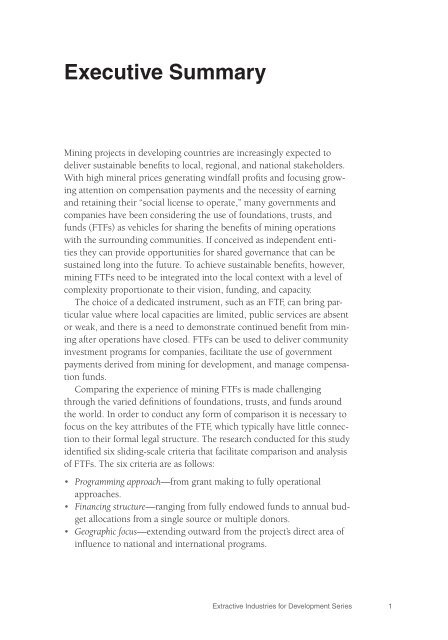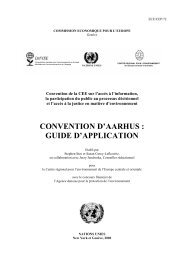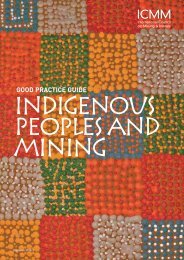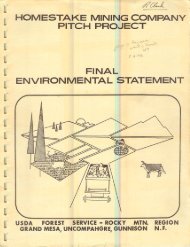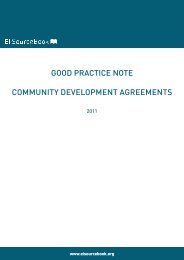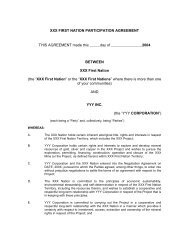Sharing Mining Benefits in Developing Countries - World Bank
Sharing Mining Benefits in Developing Countries - World Bank
Sharing Mining Benefits in Developing Countries - World Bank
Create successful ePaper yourself
Turn your PDF publications into a flip-book with our unique Google optimized e-Paper software.
Executive Summary<strong>M<strong>in</strong><strong>in</strong>g</strong> projects <strong>in</strong> develop<strong>in</strong>g countries are <strong>in</strong>creas<strong>in</strong>gly expected todeliver susta<strong>in</strong>able benefits to local, regional, and national stakeholders.With high m<strong>in</strong>eral prices generat<strong>in</strong>g w<strong>in</strong>dfall profits and focus<strong>in</strong>g grow<strong>in</strong>gattention on compensation payments and the necessity of earn<strong>in</strong>gand reta<strong>in</strong><strong>in</strong>g their “social license to operate,” many governments andcompanies have been consider<strong>in</strong>g the use of foundations, trusts, andfunds (FTFs) as vehicles for shar<strong>in</strong>g the benefits of m<strong>in</strong><strong>in</strong>g operationswith the surround<strong>in</strong>g communities. If conceived as <strong>in</strong>dependent entitiesthey can provide opportunities for shared governance that can besusta<strong>in</strong>ed long <strong>in</strong>to the future. To achieve susta<strong>in</strong>able benefits, however,m<strong>in</strong><strong>in</strong>g FTFs need to be <strong>in</strong>tegrated <strong>in</strong>to the local context with a level ofcomplexity proportionate to their vision, fund<strong>in</strong>g, and capacity.The choice of a dedicated <strong>in</strong>strument, such as an FTF, can br<strong>in</strong>g particularvalue where local capacities are limited, public services are absentor weak, and there is a need to demonstrate cont<strong>in</strong>ued benefit from m<strong>in</strong><strong>in</strong>gafter operations have closed. FTFs can be used to deliver community<strong>in</strong>vestment programs for companies, facilitate the use of governmentpayments derived from m<strong>in</strong><strong>in</strong>g for development, and manage compensationfunds.Compar<strong>in</strong>g the experience of m<strong>in</strong><strong>in</strong>g FTFs is made challeng<strong>in</strong>gthrough the varied def<strong>in</strong>itions of foundations, trusts, and funds aroundthe world. In order to conduct any form of comparison it is necessary tofocus on the key attributes of the FTF, which typically have little connectionto their formal legal structure. The research conducted for this studyidentified six slid<strong>in</strong>g-scale criteria that facilitate comparison and analysisof FTFs. The six criteria are as follows:• Programm<strong>in</strong>g approach—from grant mak<strong>in</strong>g to fully operationalapproaches.• F<strong>in</strong>anc<strong>in</strong>g structure—rang<strong>in</strong>g from fully endowed funds to annual budgetallocations from a s<strong>in</strong>gle source or multiple donors.• Geographic focus—extend<strong>in</strong>g outward from the project’s direct area of<strong>in</strong>fluence to national and <strong>in</strong>ternational programs.Extractive Industries for Development Series1


